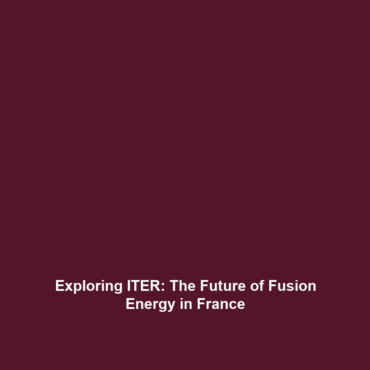Notable Projects in Fusion Energy: ITER’s Role in Advancing Tokamak Technology
Introduction:
ITER, the International Thermonuclear Experimental Reactor, represents a monumental leap in the pursuit of sustainable fusion energy. Located in France, it is currently the largest fusion experiment being constructed, designed to demonstrate the feasibility of tokamak reactors in generating clean and abundant power. As global energy demands rise and concerns about climate change grow, projects like ITER are pivotal in shaping the future of energy. This article delves into the significance of ITER within the broader context of fusion energy research and its potential to revolutionize power generation.
Key Concepts of ITER and Fusion Energy
The core principle driving ITER is nuclear fusion—the same process that powers the sun. By fusing lightweight atomic nuclei, such as hydrogen, into heavier nuclei, vast amounts of energy can be released. The following are some fundamental concepts related to ITER:
1. Tokamak Reactor Design
ITER utilizes the tokamak design, which employs magnetic fields to confine hot plasma. In this reactor, deuterium and tritium isotopes of hydrogen are heated to extremely high temperatures, facilitating fusion reactions.
2. Plasma Physics
The study of plasma physics is crucial for understanding how to achieve and maintain the necessary conditions for fusion. ITER aims to maintain a stable plasma state long enough to produce more energy than is consumed—a key measurable outcome of the project.
3. ITER’s International Collaboration
Jointly funded by multiple countries, ITER symbolizes global cooperation in fusion research. The project combines expertise and resources from 35 nations, including the European Union, the United States, China, India, Japan, South Korea, and Russia.
Applications and Real-World Uses of ITER
As ITER progresses, its applications in fusion energy become increasingly relevant. Here are some notable applications:
- Energy Generation: If successful, ITER could provide insights into commercial fusion power plants, offering a sustainable energy source with minimal environmental impact.
- Advanced Research: ITER acts as a testbed for new technologies that can be applied to future fusion reactors, emphasizing innovation in energy solutions.
- Nuclear Physics: The research conducted at ITER will significantly enhance our knowledge of plasma physics and nuclear interactions, potentially benefiting various scientific fields.
Current Challenges Facing ITER
Despite its promise, ITER faces several challenges, including:
- Technological Hurdles: Developing materials that can withstand the extreme conditions present in a tokamak reactor remains a significant challenge.
- Cost and Funding: The project has faced budget overruns and delays, requiring careful financial management and international cooperation to ensure sustained support.
- Engineering Complexity: The intricacies of constructing and operating such a large-scale facility pose logistical and technical issues that must be continually addressed.
Future Research and Innovations
Looking ahead, the ITER project is poised to lead to several innovations in the field of fusion energy:
- Next-Generation Materials: Research is ongoing into advanced materials capable of enduring prolonged exposure to neutron radiation.
- Improved Plasma Control: Innovations in plasma stabilization technologies aim to address potential disruptions and enhance performance.
- Commercial Fusion Power Plants: Success at ITER may pave the way for the development of viable commercial fusion reactors, fulfilling energy demands sustainably.
Conclusion
ITER stands as a beacon of hope in the quest for sustainable fusion energy. Its research and development efforts are essential for proving the viability of tokamak reactors for power generation. As we continue to overcome challenges and pursue innovative solutions, the implications of ITER extend far beyond its immediate objectives, promising a cleaner, more sustainable energy future. For further reading on fusion energy developments, explore our articles on tokamak technologies and the future of renewable energy sources.
This document provides a structured overview of the ITER project, highlighting its significance and relevance in the field of fusion energy, while optimizing the content for search engines.

